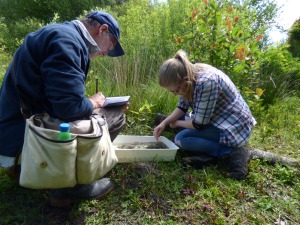Day Eleven of Megan & Matt Go Wild!
Welcome to our joint-blogging series for the Wildlife Trusts’ 30 Days Wild Challenge – you can read more about the campaign and ourselves in our introduction page.
Megan (in coastal Dorset)
It was another office day for me – spending much of the time glued to my laptop preparing for events and the like. I could hear the leaves rustling outside, and a Chiffchaff that was determined to make sure that everyone knew he was present in the area.
I decided to work downstairs at Lorton, rather than up out of the way in the office. A bit more sociable for talking to visitors, plus it lets me keep an eye on live kestrel camera.
By the time I managed to grab a late lunch, I needed to get outside so headed to the picnic benches to munch. Having attended a time management training session, I was reminded of how important it is to actually take a break. I am definitely guilty of having short breaks, and usually working whilst I eat too.
I have to say, it was a lovely break. A small fly popped by to say hello, I followed the fluttering adventures of a blue butterfly across the vegetation, read a little bit of my book and generally basked in the sun. Must take such lunch breaks more often!
Lunch outside at @DorsetWildlife's Lorton Meadows Nature Reserve. #30DaysWild @mattadamw @wildlifetrusts pic.twitter.com/ouN4iSCm5t
— Megan Shersby (@MeganShersby) June 11, 2015
Matt (in Cambridge/Sandy)
June is not just one of my wildest ever months but also one of my busiest.
Even though I was working at home today I felt the stress of several projects crunching together at the same time.
This is a short blog post, but it’s dedicated to the immense power of nature to calm and soothe us.
At my most stressed moment today I stepped out into my garden and noticed a blue-tailed dameslfly flitting about delicately near my tiny garden pond.
Among the huge poppies and oxeye daisies in my back garden this moment of quiet contemplation calmed me down and set me up for a few more hours’ work.







































